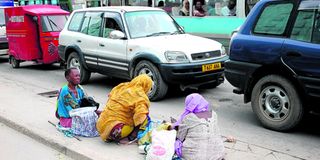Why begging in urban areas of Tanzania is on the increase

Beggars on a Dar es Salaam street. There has been an increase in the number of beggars in many Tanzanian cities and towns lately. photo | FILE
Begging, which is on the increase in urban Tanzania, has been defined as requesting a donation in a supplicating manner. Besides dealing with the Machinga Problem, the Dar es Salaam Regional Commissioner, did hint at addressing the problems of urban beggars in the city.
Beggars are commonly found in public places such as street corners and junctions, traffic lights, houses of prayer, and elsewhere, where they normally request money. They may use cups, boxes or hats to collect the donations. Some beggars have assistants who will carry them to a vantage point and keep an eye on them and sometimes bring them food, and water. Others are taken around eg on a wheel chair, by well-abled people through public places such as bars soliciting for alms.
Beggars tend to locate where they are seen easily, so you find them sitting or standing in the scorching sun at a vantage point for hours. Such locations may not be comfortable; but they elicit sympathy. Assistants may bring them an umbrella, or some water to quench their thirst. In some cases, the assistants are children, guiding a blind elder. Donations are received by the actual beggear who later gives his/her guide part of it.
Some beggars are handicapped or are senior citizens. Some are boys and girls. They may be blind or lame. Others have no visible physical disability. Occasionally one sees women begging into the middle of the night, sometimes carrying babies
Lack of an official social welfare system forces the poor in rural areas to gravitate to urban areas and eke out a living as beggars.
Beggars feel that they are entitled to support from those whom they considered to be better off. The latter include traders, motorists, expatriates, tourists and revellers. Thus, the preponderance of beggars at traffic light junctions. On the other hand, there are beggars who move from office to office or from one public gathering place (eg a bar) to another. If people can drink, they surely can donate to the poor!
Begging time coincides with when most people are active, the working hours. Certain days of the week, especially Fridays, seem to attract beggars who expect to get alms from those going to or coming from prayer. There is some spirituality related to begging. People who consider themselves better off may feel that they have a duty to help the needy, and, that way attain some spiritual gratifications. Indeed, many religious teaching encourage alms giving such as zakat.
It is heart-wrenching, however, to see children who should be in school begging or assisting elders in begging. Most beggars can be considered to be poor but some may accumulate wealth and control other beggars. Listening to beggars exchanging ideas one day, I got a feeling that they had some undertakings in which they were engaged. Some have a family while others have (modest) investments in real estate. Beggars also seem to know who gives and who does not; and in giving, who gives little and who is generous.
Techniques used for begging include stretching out a hand with or without a container. Some offer unsolicited services, like washing your windscreen while you are waiting at the traffic lights. This is done strategically starting with the non-driver’s side of the vehicle. Much as the driver may chase the screen-washing person away, they will continue with their unsolicited cleaning and in the end, request for a donation. Lone vehicle occupants are targeted more than when a vehicle has multi-occupiers. These activities are not only a nuisance, but are also illegal (trespass). Moreover, one never knows what kind of liquid or chemical is being applied to one’s wind-screen, but, as a driver, you are a captive as far as these screen-washing beggars are concerned.
Sometimes one wonders whether a person begging should be begging at all. True a person may miss a limb, but should that be the licence for begging? Many of the beggars could actually engage in economic activities, but begging, despite its tribulations, seems to be the preferred mode of earning a living.
It would appear that there are areas where beggars congregate to exchange views and socialize. Some beggars have no homes and live in makeshift shacks. Many beggars rely on public buildings for conveniences.
Repatriation or sweeping of beggars from the streets is not a viable option. The starting point could be to find out more about beggar life. Given that some of the beggars are children and young mothers, there is need for the public authorities to document the begging phenomenon in our urban areas and, thereafter, evolve appropriate strategies to deal with it, including graduating beggars from begging to leading an ordinary life.





